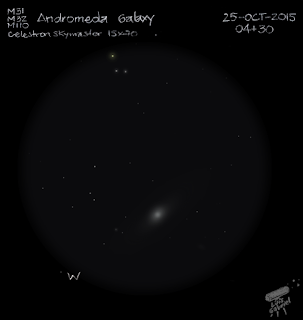Andromeda Galaxy, the most
distant object visible to the naked eye is often one of the most viewed DSOs by
amateur astronomers. It lies about 1 arc degree from the star nu Andromedae (35 And), a spectroscopic binary that is bright enough to be seen
with the naked eye in a fairly dark sky. All of the above make Andromeda Galaxy,
one of the easiest objects to locate in the sky. However, the same cannot be
said about its companions the dwarf galaxies M32 and M110.
With an apparent magnitude
of 8.1, a surface brightness of 12.46 and an angular size of 8.5' x 6.5', M32
is the easiest to see. Apparently, it seems to make a right scalene triangle
with two stars of 9th magnitude and in the binoculars it looked like a stellar,
but fuzzy object of similar magnitude to its two companions stars. I had seen
it from a Bortle 9 sky and there had been no clue that it wasn´t a non-stellar
object.
On the other side of
Andromeda lies M110. It has an apparent magnitude of 8.1, similar to M32 and a surface
brightness of 13.98 because its angular size (19.5' x 11.5') is much larger
than M32. I tried to hunt M110 in various sessions, but I only managed to see it
from my Bortle 5 sky in a night with excellent transparent and good
seeing. Despite being less affected by
Andromeda’s glance than M32 that practically lies in the outskirts of the giant
galaxy, M110 is a galaxy very tough to see (at least from my skies). It looked
like a ghostly patch and I could only perceive it with averted vision after full
dark eye adaptation.
I wish to the readers a dark
and clear sky and that the next time you take a look at Andromeda, you can see
these 3 magnificent galaxies.
LG
Edited by Jennifer Steinberg
(editor in chief)
SOURCES


This comment has been removed by the author.
ReplyDelete